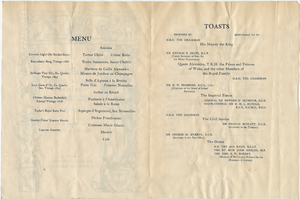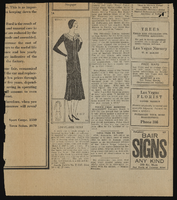Search the Special Collections and Archives Portal
Search Results
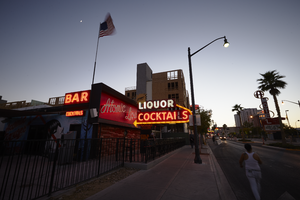
Photographs of Atomic Liquors at dusk, Las Vegas (Nev.), June 28, 2017
Date
Archival Collection
Description
Site address: 927 Fremont St
Sign owner: 100 10th Street LLC
Sign details: Property sold by Lance Johns to 100 10th Street LLC in 2014 for $3,480,000. Recent addition to property in 2017 (927 Fremont Street).
Sign condition: 3 - Decent: neon in great condition, paint chipping off and some bulbs not repaired
Sign form: Directional Monument sign, back to back "Double sided"
Sign-specific description: Uses directional tool of an arrow, has chasing animation in the arrow with incandescent bulbs. It has blade like additions to it for the word "Liquor" and "Cocktails", each word on its own blade which are parallel to the ground, they are painted red. The word "Atomic" sits on the top in a comic style "blast" shaped bubble painted yellow. "Packaged liquors" and "Cold beer" painted on the base structure of the sign. Bulbs glow yellow, "Liquor" glows blue, "Cocktails" glows red, "Atomic" is not lit.
Sign - type of display: Neon and incandescent
Sign - media: Steel
Sign animation: Chaser effect with bulbs
Sign environment: Property surrounded by other bars/clubs and motels.
Sign - date of installation: c. 1952
Sign - artistic significance: 1950s atomic testing theme - popular due to test sight 65 miles north of city
Survey - research locations: Bar website, www.roadarch.com, owner
Surveyor: Danny Jacobs
Survey - date completed: 2017-08-12
Sign keywords: Neon; Incandescent; Steel; Chasing; Directional; Monument sign; Back to back; Fascia; Floating Mount Letters
Mixed Content
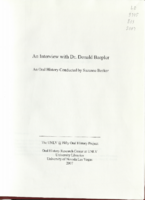
Transcript of interview with Dr. Donald Baepler by Suzanne Becker, April 23, 2007
Date
Archival Collection
Description
Text
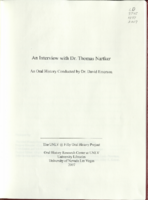
Transcript of interview with Dr. Thomas Nartker by Dr. David Emerson, November 13, 2006
Date
Archival Collection
Description
Text
Sawyer, Lynnette Arvelo
Growing up just one block away from New York’s “Museum Mile” and surrounded by cultures from every corner of the world, it’s easy to say that Lynnette Arvelo Sawyer was destined to create her own museum dedicated to the cultures she grew up with. Lynette is a proud Puerto Rican and Afro-Latina from El Barrio of East Harlem in New York; her roots extend from the island of Puerto Rico to the Canary Islands off the coast of Africa.
Person
Washington University, School of Fine Arts Collection of Student Calendars
Identifier
Abstract
The Washington University, School of Fine Arts Collection of Calendars consists of thirty-three calendars created by students in the Washington University, School of Fine Arts created in 1983.
Archival Collection
Lee and Thomas Beam Music Center Architectural Records
Identifier
Abstract
The Lee and Thomas Beam Music Center Architectural Records (1998-1999) contain architectural drawing sets for the Lee and Thomas Beam Music Center's design and construction. Located on the University of Nevada, Las Vegas campus, the Lee and Thomas Beam Music Center provides professional and liberal arts education to students seeking a career in the study and creation of music. The school enrolls more than 400 music majors and attracts students throughout America and internationally.
Archival Collection
The Story of Classic Las Vegas Oral History Interviews
Identifier
Abstract
Archival Collection

